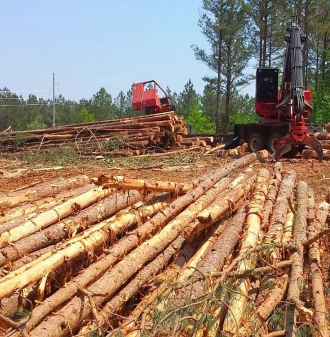
 Timberland owners in the US South who manage their land for timber production have historically managed for large diameter, high-value sawtimber logs.
Timberland owners in the US South who manage their land for timber production have historically managed for large diameter, high-value sawtimber logs.
Editor's note: The following article is authored by Stan Parton, Manager, Bioenergy Sector Sales at Forest2Market. It appears on Forest2Markets website under "Resources."
Feb. 15, 2021 - Timber and the land timber occupy are economic assets. As in any market, when there is strong demand, owners actively manage their assets to maximize economic return. In this case, timberland owners manage their forests to maximize tree growth, especially the growth of the highest valued product — sawtimber. This management structure increases their return on investment. In turn, forest products manufacturers use the raw materials that they purchase to the fullest extent possible, including the utilization of low-value trees and residuals for energy purposes where market exist.
The growth of the forest products industry — including the renewable biomass sector — continues to create new demand for wood raw materials, which has resulted in an increase, rather than a reduction, in forest inventory. These new markets are imperative for keeping the supply/demand of forest raw materials in balance, especially since southern forests have been oversupplied for the last decade.
While much of the feedstock material used to produce biomass and wood pellets consists of wood chip residues generated from other wood products manufacturing processes, it is important to clarify that many pellet producers also use low-value pulpwood in the manufacturing process. How are harvested trees routed through the forest supply chain?
The sizes of the trees removed from timberland are quite different, serve a range of needs, and therefore vary in value. In general, southern pine logs fall into one of the following categories:
Timberland owners in the US South who manage their land for timber production have historically managed for large diameter, high-value sawtimber logs. Centuries of demand for solid wood products used for structural purposes has driven this paradigm, as larger logs result in better yield and quality in solid wood product manufacturing. Landowners are therefore incentivized to grow larger logs through high price offerings for the sawtimber from solid wood product manufacturers. As such, timberland management practices have evolved over time to maximize real returns on large logs, with landowners implementing silvicultural prescriptions to yield larger, high-value logs faster.
One such management practice known as "thinning" involves removing low-value pulpwood (generally small, misshapen, deformed and off-species) trees. This process reduces competition for soil nutrients and opens the forest canopy to allow more sunlight into the timber stand, which induces higher growth rates for the remaining high-value trees. These trees continue to grow until reaching larger diameter and quality specifications to be considered for solid wood product manufacturing.
Basic economics and industry best practices ensure that harvested trees are used to maximize their value. Consider the price differential between sawtimber and pulpwood: In 3Q2020, the southwide volume weighted average price (stumpage) for pine sawtimber was roughly $25/ton, and the southwide volume weighted average price of pine pulpwood was roughly $9/ton.
Timberland owners will not harvest all of their timber as small trees at $9/ton when they can harvest mature trees at $25/ton. In addition to the higher value for larger logs, the increased growth of the trees in the intervening years also results in several additional tons of sawtimber that can be sold at the higher price. Economically, it makes no sense to do otherwise.
Therefore, there are three important points to understand about the economics of pulpwood supply:
The wood pellet industry is dwarfed by the traditional forest products industry...
The complete article with price and production charts is available at: www.forest2market.com/blog.
Forest2Market provides pricing data, supply chain expertise and strategic consulting services to participants in the global wood and fiber supply chain. To learn more, visit www.forest2market.com.
SOURCE: Forest2Market
Paper Industry Newsletter
Stay on top of paper industry news
from around the world with
PaperAge's free weekly newsletter.
Delivered every Thursday.
Sign up today!